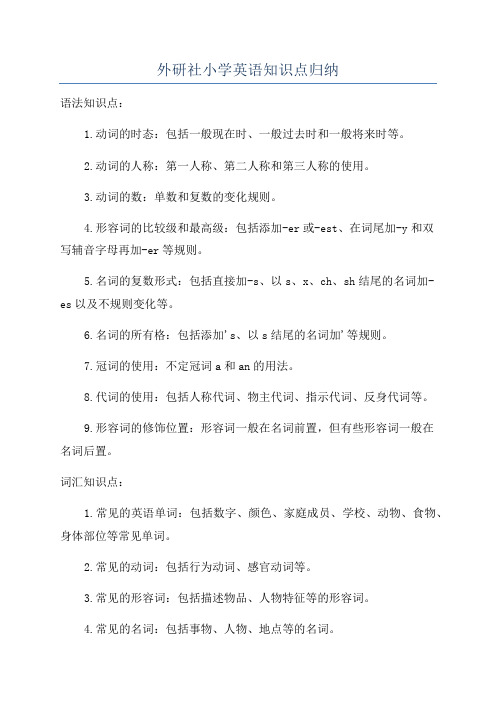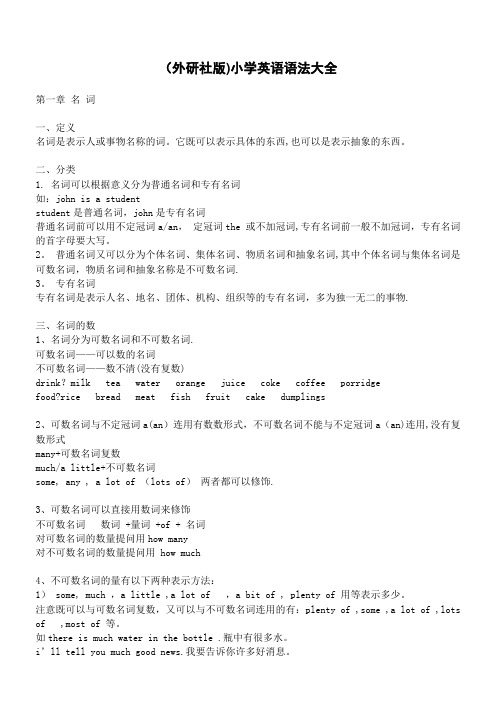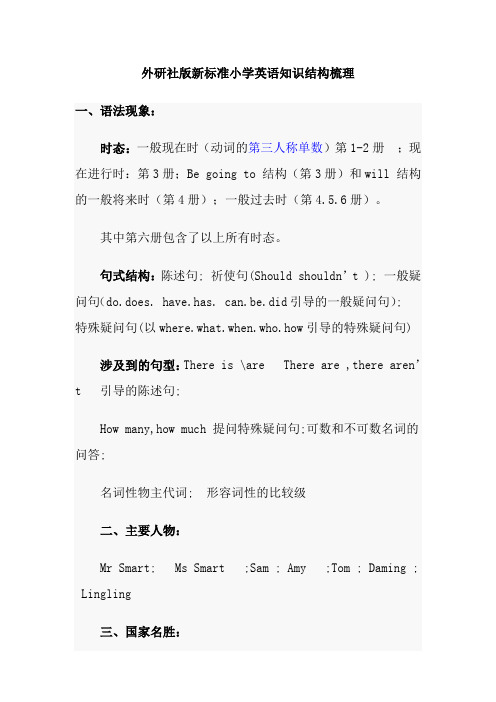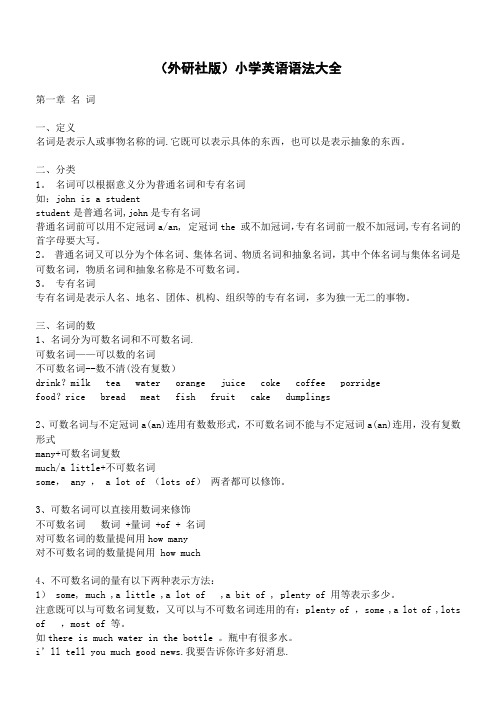外研社新标准小学英语知识点汇总
(完整word版)外研版小学英语语法总复习知识点归纳

(完整word版)外研版小学英语语法总复习知识点归纳外研版小学英语语法总复知识点归纳一、时态1.一般现在时(1)表示经常发生的动作或事情,通常用“usually通常,often常常,every…每…。
sometimes有时,always总是,”等词。
(2)基本结构:主语I / You / We / They /He / She / It肯定句:主语+动词原形或动词第三人称单数形式否定句:主语+don’t + 动词原形或者doesn’t + 动原一般疑问句(Yes/No) Do…。
Yes。
I do.No,I don’t.Does…(动词原形)…?Yes,he/she does。
No,he/she doesn’t.特殊疑问句What do …。
How does she…(动词原形)…?(3)动词第三人称单数方式(同名词单数酿成复数办法不异)1.普通情形+s如:walk-walks2.辅音字母+y结尾去y +ies fly-flies3.结尾是s。
x,sh。
ch +es watch-watches4.结尾是0 +es do-does。
go-goes5.特殊have-has2.现在进行时(1)表示正在发生的动作,通常用“now现在。
look看,XXX听”.(2)根本方式: be +动词-ingeg: I am(not) XXX.You/We/They are(not) reading。
He/She/It is(not) eating.What are you doing。
Is he reading?(3)动词的目前分词方式(动词+ing)普通情形+ing walk—walking末端是不发音的e-e+ingcome—coming重读闭音节双写末了一个字母+ingswim-swimming。
run-running3.一般过去时(1)表示过去已经发生的事情,通常用“last …上一个…。
just now刚才,many years ago许多年前,XXX昨天”等词。
外研社小学英语1至6年级知识点

外研社小学英语1至6年级知识点表示将要发生的事情或将要进行的动作,常与tomorrow,next(week,month,year),soon等词连用。
结构是主语+will+动词原形。
如:XXX.我明天要去上学。
XXX.他们下周末要去野餐。
XXX?明天会晴朗吗?问句直接将will放在主语前即可;否定句在will后面加not。
5.情态动词情态动词有can,could,shall,should,will,would,may,might,must等,表示能力、意愿、推测、必要性等。
结构是主语+情态动词+动词原形。
如:XXX.我会弹钢琴。
XXX.我们应该保护环境。
XXX.你的工作必须勤奋。
Couldyoupleaseturnoffthelights?你能关灯吗?问句直接将情态动词放在主语前即可;否定句在情态动词后面加not。
如box—boxes;bus—buses;brush—brushes;watch—watches。
3)以辅音字母+y结尾的把y改为i再加es如baby—babies;city—cities。
4)以o结尾的有两种情况,一种加s,一种加es如XXX;hero—XXX。
不规则的有:如man—men;woman—women;child—children;foot—feet;XXX。
16.冠词冠词分为定冠词the和不定冠词a/an。
a用于以辅音字母开头的单数可数名词前,an用于以元音字母开头的单数可数名词前。
如:a book;an apple。
XXX用于特指的名词前,或表示一类事物中的某一具体事物时。
如:The Great Wall;the book on the table。
17.比较级和最高级形容词比较级的构成方法是在形容词后加er,或在前面加more,最高级的构成方法是在形容词后加est,或在前面加most。
如:taller;more beautiful;the tallest;the most beautiful。
外研社小学英语知识点归纳

外研社小学英语知识点归纳语法知识点:1.动词的时态:包括一般现在时、一般过去时和一般将来时等。
2.动词的人称:第一人称、第二人称和第三人称的使用。
3.动词的数:单数和复数的变化规则。
4.形容词的比较级和最高级:包括添加-er或-est、在词尾加-y和双写辅音字母再加-er等规则。
5.名词的复数形式:包括直接加-s、以s、x、ch、sh结尾的名词加-es以及不规则变化等。
6.名词的所有格:包括添加's、以s结尾的名词加'等规则。
7.冠词的使用:不定冠词a和an的用法。
8.代词的使用:包括人称代词、物主代词、指示代词、反身代词等。
9.形容词的修饰位置:形容词一般在名词前置,但有些形容词一般在名词后置。
词汇知识点:1.常见的英语单词:包括数字、颜色、家庭成员、学校、动物、食物、身体部位等常见单词。
2.常见的动词:包括行为动词、感官动词等。
3.常见的形容词:包括描述物品、人物特征等的形容词。
4.常见的名词:包括事物、人物、地点等的名词。
5.常见的副词:包括表示时间、地点、方式等的副词。
6.常见的连词:包括连接句子、词组、并列和对比等的连词。
句子结构和表达:1.陈述句的构成和基本结构:主语+谓语+宾语。
2.疑问句的构成:包括一般疑问句、特殊疑问句等。
3.否定句的构成:一般在谓语动词前加not。
4.祈使句的构成:以动词开头,表示命令或请求。
5.感叹句的构成:以助词what或how开头,表示惊讶、赞美、遗憾等情感。
6.常见的句型:包括There is/are, I can/can't, I like/don't like等常见句型。
阅读技巧:1.辨别词义:通过上下文理解词义。
2.理解句意:通过关键词和句子结构等推断句意。
3.找主题句:通过段落的第一句或总结句等找到段落的中心思想。
4.理解标题:通过预测段落内容和文章整体思路等理解标题含义。
5.寻找信息:通过关键词、答案选项等快速找到问题的答案。
(外研社版)小学英语语法大全

(外研社版)小学英语语法大全第一章名词一、定义名词是表示人或事物名称的词。
它既可以表示具体的东西,也可以是表示抽象的东西。
二、分类1. 名词可以根据意义分为普通名词和专有名词如:john is a studentstudent是普通名词,john是专有名词普通名词前可以用不定冠词a/an,定冠词the 或不加冠词,专有名词前一般不加冠词,专有名词的首字母要大写。
2。
普通名词又可以分为个体名词、集体名词、物质名词和抽象名词,其中个体名词与集体名词是可数名词,物质名词和抽象名称是不可数名词.3。
专有名词专有名词是表示人名、地名、团体、机构、组织等的专有名词,多为独一无二的事物.三、名词的数1、名词分为可数名词和不可数名词.可数名词——可以数的名词不可数名词——数不清(没有复数)drink?milk tea water orange juice coke coffee porridgefood?rice bread meat fish fruit cake dumplings2、可数名词与不定冠词a(an)连用有数数形式,不可数名词不能与不定冠词a(an)连用,没有复数形式many+可数名词复数much/a little+不可数名词some, any , a lot of (lots of)两者都可以修饰.3、可数名词可以直接用数词来修饰不可数名词数词 +量词 +of + 名词对可数名词的数量提问用how many对不可数名词的数量提问用 how much4、不可数名词的量有以下两种表示方法:1) some, much ,a little ,a lot of ,a bit of , plenty of 用等表示多少。
注意既可以与可数名词复数,又可以与不可数名词连用的有:plenty of ,some ,a lot of ,lots of ,most of 等。
如there is much water in the bottle .瓶中有很多水。
外研社新标准小学英语三起点资料

外研社新标准小学英语三起点第一册Module 1 Unit 1 I'm Sam知识点:1. 简单自我介绍句型I'm= I am 在后面接名字。
后面除了接名字外,还可以接自己的职业,或者是形容词。
本课学习的是第一种,在后面会学习第二种和第三种。
a)接名字: I'm Sam. 我是山姆,我的名字叫山姆,用你的名字来试试吧。
b)接职业:I am a student.c)接形容词:I am sorry.2. 简单的问候用语Hello. 你好。
Hi. 嗨。
Good morning. 早上好。
How are you?你好吗?Thank you!谢谢Good-bye!再见!Bye-bye!再见!3. 有介绍用语就有询问句型,本课学习一个句型及其回答,就是What's your name? 你叫什么名字?(what’s=what is)回答就是本课的句型 I'm ... 和你的小伙伴一起来试试吧。
What’s your name?回答:1) I’m Jenny.2)My name’s Jenny .What’ his name?His name’ Tony.What’ her name?Her name’ Jenny.单词:I 我am 是(be第一人称单数)hello 喂;哈罗(表示问候,惊奇或唤起注意时的用语)例句:Hello, Jim! How are you?哈罗,吉姆,你好吗?hi 嗨!(表示问候或用以唤起注意)googbye (bye-bye原为儿语)再见教案:外研社新标准小学英语模块1第一单元教学方案设计一:1、教学内容:学生用书:第一册第一模块第一单元活动用书:第一册第一模块第一单元活动1,活动22、教学目的:2.1技能与知识目标:A.基本要求:1.基本能听懂会说:‚Hello, Hi, Goodbye, bye-bye‛2.学会运用句型‚I’m…‛进行自我介绍。
外研社版新标准小学英语知识结构梳理

外研社版新标准小学英语知识结构梳理一、语法现象:时态:一般现在时(动词的第三人称单数)第1-2册;现在进行时:第3册;Be going to 结构(第3册)和will 结构的一般将来时(第4册);一般过去时(第4.5.6册)。
其中第六册包含了以上所有时态。
句式结构:陈述句; 祈使句(Should shouldn’t ); 一般疑问句(do.does. have.has. can.be.did引导的一般疑问句);特殊疑问句(以where.what.when.who.how引导的特殊疑问句) 涉及到的句型:There is \are There are ,there aren’t 引导的陈述句;How many,how much 提问特殊疑问句;可数和不可数名词的问答;名词性物主代词; 形容词性的比较级二、主要人物:Mr Smart; Ms Smart ;Sam ; Amy ;Tom ; Daming ; Lingling三、国家名胜:China:Beijing;the Great Wall;the Summer Place;Mount QomolangmaEngland:London;Big Ben;Tower Bridge;Hyde Park;the B uckingham Palace;the London Eye;the River Thames; the British Museum America: Washington D. C. ; New York;San Francisco四、主要节日:Spring Festival ; Christmas; Halloween; Mother’s d ay; F ather’s day; Fools day五、话题分类:1:问候介绍;教室学校;颜色;数字;家庭;身体;2:动物园;食物;时间;节日;季节和天气;位置;3:方位;活动;能力;旅行计划;请求;月份;4:野餐;音乐;国家;变化;周末;事件5:谈论过去;购物;评价;习惯和行为规则;6:图书馆;发送电子邮件;别人提建议;旅游见闻;旅行前的准备六、词汇分类:动物:1:bird ;panda; dog; cat; 2:monkey; tiger ;lio n ;elephant;5: chick ;6:horse ;dragon颜色:1:red ;blue;yellow;green;black;3:purple;pink; white;orange水果:2:banana;pear;orange;apple;3:fruit; 4:waterme lon服装:1:cap;hat; 2:dress; coat; sweater; T-shirt;6: shoe职业:1:teacher; driver; policeman; nurse; farmer 6: dancer ;actor家庭:1:mother; father; grandpa; grandma; sister; br other; mum ; dad; me ;3:friend 6:grandchildren;grandmot her ; parent; cousin科目:2:Chinese ; Maths; Science; Music; Art; PE; 6: History文具:1:bag;pencil; pen; book; 6:dictionary身体:1: head; arm; shoulder; knee; leg; foot ; toe s; nose; eye; ear;4: hair月份:3:January; February; March; April; May; June; July; August; September; October; November ;December 季节:2;spring; summer ; autumn; winter星期:4: Monday; Tuesday; Wednesday; Thursday; Frid ay; Saturday; Sunday天气:2: hot; warm; cool; cold; sunny; windy; sno w性格:4:nice; shy; clever; naughty; cool; cute; goo d; bad疾病:4:stomachache ;cold; headache; fever数字:1:one ; two; three; four; five; six; seven; eight; nine; ten ; eleven; twelve;3:thirteen; fourteen; fifteen ;sixteen; seventeen; eighteen; nineteen; twent y;交通工具:2: car ; ship; bike; bus; 3:train; 6: boa t; taxi食品饮料:2:meat ;rice; noodles; fish; milk; peanut s ; sweets; 3: soup; vegetable; bread; biscuits;4:icecr eam ; food; cheese; juice; 5: sausage; coffee; hot dog: egg; sandwich; hamburger介词及方位:1:in ; 2:on; under ;3: up; down ; 4: ea st; south; west; north特殊动词的过去式:4:fell off ; went; bought; had; 5: met; ran; rang; lost; told; 6: ate ; gave; drank; wore; made名词性物主代词:5:mine; yours; hers; his; its形容词:2: big; small; fat; tall; short; thin;3: li ttle; interesting; hungry; nice; difficult;4:beautiful; long; wide; old; famous; young; strong; thirsty; bette r; worse; good; bad; last; 5: blind; deaf; sad; bored; angry; surprise; tired; dangerous; careful; fantansti c ; useful;6: different; retired; traditional; deliciou s; light; broken; heavy; hard; busy; funny;ready。
(外研社版)小学英语语法大全

(外研社版)小学英语语法大全第一章名词一、定义名词是表示人或事物名称的词.它既可以表示具体的东西,也可以是表示抽象的东西。
二、分类1。
名词可以根据意义分为普通名词和专有名词如:john is a studentstudent是普通名词,john是专有名词普通名词前可以用不定冠词a/an, 定冠词the 或不加冠词,专有名词前一般不加冠词,专有名词的首字母要大写。
2。
普通名词又可以分为个体名词、集体名词、物质名词和抽象名词,其中个体名词与集体名词是可数名词,物质名词和抽象名称是不可数名词。
3。
专有名词专有名词是表示人名、地名、团体、机构、组织等的专有名词,多为独一无二的事物。
三、名词的数1、名词分为可数名词和不可数名词.可数名词——可以数的名词不可数名词--数不清(没有复数)drink?milk tea water orange juice coke coffee porridgefood?rice bread meat fish fruit cake dumplings2、可数名词与不定冠词a(an)连用有数数形式,不可数名词不能与不定冠词a(an)连用,没有复数形式many+可数名词复数much/a little+不可数名词some, any , a lot of (lots of)两者都可以修饰。
3、可数名词可以直接用数词来修饰不可数名词数词 +量词 +of + 名词对可数名词的数量提问用how many对不可数名词的数量提问用 how much4、不可数名词的量有以下两种表示方法:1) some, much ,a little ,a lot of ,a bit of , plenty of 用等表示多少。
注意既可以与可数名词复数,又可以与不可数名词连用的有:plenty of ,some ,a lot of ,lots of ,most of 等。
如there is much water in the bottle 。
外研版小学英语语法知识点汇总

外研版小学英语语法知识点汇总外研版小学英语语法知识点汇总一、词类1、名词:表示人、物或抽象概念的词。
例如:apple、class、happiness。
2、动词:表示动作或状态的词。
例如:run、eat、sleep。
3、形容词:描述人或物的特征和属性的词。
例如:beautiful、tall、fast。
4、副词:修饰动词、形容词或其他副词的词。
例如:quickly、happily、very fast。
5、介词:表示人或物在时间、地点或空间中的位置关系的词。
例如:in、on、at。
6、代词:代替名词的词。
例如:it、that、who。
二、时态1、现在时:表示现在的动作或状态。
例如:I eat an apple. They are playing football.2、过去时:表示过去的动作或状态。
例如:I ate an apple. They played football.3、现在进行时:表示现在正在进行的动作或状态。
例如:I am eating an apple. They are playing football.4、过去进行时:表示过去正在进行的动作或状态。
例如:I was eating an apple. They were playing football.5、现在完成时:表示已经完成的动作或状态,强调结果。
例如:I have eaten an apple. They have played football.6、过去完成时:表示在过去某个时间之前已经完成的动作或状态。
例如:I had eaten an apple. They had played football.三、句子结构1、主语+谓语:最基本的句子结构,表示一个动作或状态。
例如:I jump. They run.2、主语+谓语+宾语:表示一个动作或行为及其对象。
例如:I eat an apple. They play football.3、主语+谓语+间接宾语+直接宾语:表示一个动作或行为及其间接对象和直接对象。
- 1、下载文档前请自行甄别文档内容的完整性,平台不提供额外的编辑、内容补充、找答案等附加服务。
- 2、"仅部分预览"的文档,不可在线预览部分如存在完整性等问题,可反馈申请退款(可完整预览的文档不适用该条件!)。
- 3、如文档侵犯您的权益,请联系客服反馈,我们会尽快为您处理(人工客服工作时间:9:00-18:30)。
日常活动
外研社 外研社 外研社 外研社 外研社
4上 4上 4上 4上 4上
外研社 外研社
外研社
4上 4上
4下
Chinese people invented paper./He invented 4 this bicycle.
We went to the Great Wall./I wore warm 5 clothes.
描述音乐比赛
What happened to your head?/I bumped my 9 head. 10 Go to bed early./Eat vegetables every day.
Don't touch the machines,please!/Don't feed 1 the fish!
询问天气状况
外研社 2 下
She's listening to the radio./I'm drawing a 2 picture.
他/她正在做某 事
外研社 2 下
描述正在进行
的动作;询问
Sam isn't tidying his room./Are you doing your 和回答正在金
3 homework?
教材版本 年级 学期 单元 标题
外研社 1 上
1 Hello!/How are you?
外研社 1 上
2 What's your name?/I am a boy.
外研社 1 上
3 Sit down!/Point to the window!
外研社 1 上
4 It's red./It's a red dog.
鼎的事情
外研社 2 下
4 What are you doing?/What's he doing?
综合运用现在 进行时
外研社 2 下
Lingling is skipping./What are the kids 5 playing?
描述他人正在 做的游戏
外研社 2 下
I usually play basketball./My grandma usually
3下 3下
外研社 3 下
2 It's very long./You'll see Tower Bridge.
建筑物特征
We'll go to the zoo./Will we have breakfast at 动物园
3 7?
周末活动
4 We'll pick fruit./Thirteen, fourteen, fifteen… 农场摘水果
手工制作 时间
外研社 外研社 外研社
4下 4下 4下
He lives in the east of the US./It's in the north 8 of China.
Why do you like Australia?/Kangaroos live in 9 Australia.
I'll send you a postcard./I'm going to visit 10 London.
8 are two footballs under my desk.
数字
9 I like football./What's your favourite sport? 喜爱
10 Let's play football!/Let's sing!
课外活动
外研社 外研社
2上 2上
1 I like the ABC song./I like football. 2 I don't like meat./I don't like ginger.
4 I can jump far./What can you see?
询问他人能力
5 Can I have an ice cream?/Can I come in?
I've got new shorts and new shoes./He's got a
6 new shirt.
外研社 3 上
外研社 外研社
生病、意外 就医及建议
不安全行为
外研社 外研社
4下 4下
It's cheap./It costs one hundred and eighteen 2 yuan.
He shouted, "Wolf, wolf!"/She went into a 3 shop.
物品特点及价 格
讲述过去发生 的事
外研社 外研社
It was my birthday on Saturday./I've got a new
1 friend.
朋友
外研社 4 上 外研社 4 上
2 I helped my mum./Amy painted a picture.
昨天做的事
She didn't walk to school yesterday./I didn't 3 play football.
外研社 2 下
9 Turn left!/Where do you live?
问路及居住地
外研社 2 下
10 It's next to the park./He's helping a child.
外研社 3 上
Do you use chopsticks in UK?/I'm eating 1 hamburgers and chips.
询问及回答中 西方习俗
外研社 3 上
2 We are making a cake./I'm watching TV.
询问和描述他 人正在做什么
外研社
外研社 外研社
外研社
3上
3上 3上
3上
These ducks are very naughty!/The ducks are 3 playing in the rain.
喜好 食物方面的喜 好
外研社 2 上
3 Do you like bananas?/Do they like apples?
外研社 2 上
Sam likes T-shirts./He doesn't like these 4 trousers.
外研社 2 上
5 At 7, I get up./I go home at 5.
3上 3上
7 Have you got a headache?/She's got a cold.
This is Sam's book./Is this your grandma's 8 umbrella?
I'm going to do the long jump./I'm going to 9 be a driver.
超市购物
Today is Halloween./Easter is in spring in the 万圣节,复活
3 UK.
节
外研社 5 上
We're going to tell stories./I'm going to be 4 eleven.
物品问答 数字,多少 年龄和生日
外研社 1 上
10 That is my father./That is his car.
介绍家庭成员
外研社
外研社
外研社 外研社
1下
1下
1下 1下
1 He's a doctor./She's a nurse. Where's the bird?/The toy car is under the
物品所属 运动会 未来职业
外研社 3 上 外研社 3 下
Are you going to Hong Kong?/What are you
10 going to see?
旅行
1 She is very nice./I'm going to help her.
人物性格,品 质
外研社 3 下
外研社 外研社
农场里的动物
动物园里的动
6 These snakes are short./They're little and cute. 物
There is a cat in the tree./There are three
动物园里有什
7 brown monkeys.
么
There's a pair of shorts under that duck./There 衣物,位置,
4下 4下
4 Dad played the erhu./I was very nervous. We are having a party./He's drawing books
5 and birds.
过去的音乐会 聚会
外研社 外研社
4下 4下
I'll draw the pictures./Let's have fun this 6 Saturday! 7 What's the time?/It's 6:30 am in New York.
国家位置方向 喜欢的国家及 原因
假日计划
外研社 5 上
There wasn't a clock here before./There are tall
1 trees now.
过去现在对比
外研社 5 上 外研社 5 上
This one is heavy./They sell many different 2 things.
